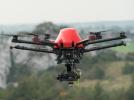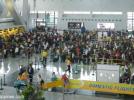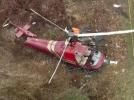Aer Arann AT72 at Cork on May 13th 2012, hard landing
The Irish AAIU released their final report reporting the occurrence's rating was changed to serious incident. The AAIU concluded the probable cause of the serious incident was:
Probable Cause
- Inadequate control of aircraft pitch in the flare during a crosswind landing in gusty and turbulent conditions.
Contributory Causes
- The average approach speed exceeded the calculated VAPP by approximately 5 kts which, when combined with the gusts experienced during the flare, may have contributed to the bounce.
- An operational restriction on the Commander meant that he could not make an approach to RWY 25, which had a significantly lower crosswind component than that experienced on RWY 17.
The AAIU reported that the aircraft was approaching Cork when the crew was informed winds were coming from 240 degrees at 16 knots, maximum 27 knots, minimum 7 knots, ATC offered vectors for a VOR approach to runway 25. As the newly promoted commander (36, ATPL, 2,161 hours total, 1,946 hours on type) assisted by a first officer (25, CPL, 400 hours total, 200 hours on type), had no operator's short runway qualification the offer was declined and the aircraft continued to position for an ILS approach to runway 17. The crew computed a maximum right crosswind component of 25 knots, the captain remarked "So, hopefully it won't go up!"
The aircraft captured localizer and glideslope, tower informed maximum winds at 24 knots, during flare of 23 knots. The captain was entirely happy to continue the approach, that was turbulent and gusty but not worse than on other flights the crew had experienced. The aircraft flared normally, both main gear touched down smoothly at about 3.2 degrees nose up, about 80 feet per minute sink rate and about 1.27G vertical acceleration. The aircraft slightly bounced not felt by the crew, the captain applied nose down inputs to lower the nose which, together with the bounce, rapidly changed the attitude of the aircraft to 3.2 degrees nose down.
The aircraft touched down a second time with the nose gear only, both main gear still off the runway, at a "noticeable" vertical acceleration of 1.707G, the captain immediately applied nose up elevator inputs and initiated a go-around, it is likely that the main gear touched down a second time. The aircraft climbed out, positioned for another approach and landed safely.
The aircraft was grounded for an inspection. The captain decided to stand down the crew, who returned to their base by road.
The AAIU reported that a subsequent inspection of the aircraft revealed no visible damage to the aircraft. However, the aircraft manufacturer being sent the flight data and asked for statement replied: "This kind of attitude is not foreseen in the JAR/FAR3/ATR certification basis as design criterion neither for Landing Gears nor for Airframe." The nose landing gear was replaced and withdrawn from service as result.
The AAIU analysed that the newly promoted captain had a 5 knots reduction on crosswind limits permitted, his maximum cross wind limit therefore was 25 knots. The first wind report indicated the maximum cross wind component would be 25.4 knots, however, the captain was permitted to continue the approach as the gusts did not need to be included in that computation, the landing however could not have continued had the present winds exceeded 25 knots of cross wind component. The remark "hopefully we don't go up" suggests the captain was aware, that any increase in wind speed during final approach would have required a go-around. Wind reports during final approach indicated a decrease in windspeed, so that the captain was entirely correct in continuing the approach.
The crew had computed a Vref of 110 KIAS, due to the wind and large gusts Vapp was determined to be 120 KIAS.
There were gusting winds and related speed fluctuations on final approach as the aircraft descended through and below 500 feet AGL, the approach in general was stabilized however.
During the flare there was a left rudder input, obviously to de-crab the aircraft, however, the aircraft responded the opposite way obviously reacting to a gust received from the right hand, the aircraft also experienced rolling motions, there were continuous aileron and elevator inputs.
After the main gear had touched down at a nose up attitude of 3.2 degrees, the main gear bounced slightly off the runway, a large nose down input occurred, the captain reporting he did not feel the aircraft had bounced and wanted to lower the nose onto the runway, the combined motion of the bounce and nose down input led to a rapid change of the attitude from +3.2 degrees to -3.2 degrees, the nose gear touched down with both main gear airborne resulting in a vertical acceleration of 1.707G.
The AAIU stated: "The fact that the average approach speed exceeded the calculated VAPP by approximately 5 kts, when combined with the gusty conditions experienced during the flare, may have contributed to the bounce."
The data then show the captain reacted very quickly by pulling the control column back to pull the nose up again. It is likely that during that motion the main gear touched down a second time. The AAIU stated: "It is likely that, in the gusty conditions which were evident during the flare and which required considerable control inputs on the ailerons and rudder, the Commander’s control of the elevator was insufficient to prevent it from moving rapidly downwards with a consequent sudden pitch down of the nose."
The AAIU analysed: "The Investigation is of the opinion that the Operator should consider the qualification of Commanders for landings on RWY 25 in EICK at the earliest opportunity following their upgrade to captain. A Safety Recommendation is issued in this regard."
The operator notified the AAIU that the short/narrow runway qualification requirement is being withdrawn and replaced by revised operational and training procedures.
Flight data (Graphics: AAIU):
http://avherald.com/h?article=4505a344/0000














Komentarze